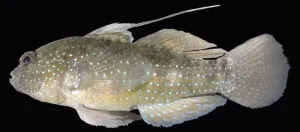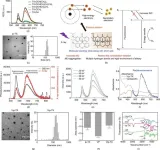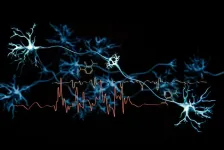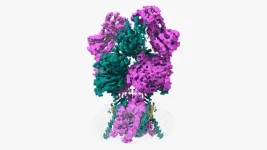(Press-News.org) New research led by scientists at the Smithsonian proposes a plan to safeguard Earth’s imperiled biodiversity by cryogenically preserving biological material on the moon. The moon’s permanently shadowed craters are cold enough for cryogenic preservation without the need for electricity or liquid nitrogen, according to the researchers.
The paper, published today in BioScience and written in collaboration with researchers from the Smithsonian’s National Zoo and Conservation Biology Institute (NZCBI), Smithsonian’s National Museum of Natural History, Smithsonian’s National Air and Space Museum and others, outlines a roadmap to create a lunar biorepository, including ideas for governance, the types of biological material to be stored and a plan for experiments to understand and address challenges such as radiation and microgravity. The study also demonstrates the successful cryopreservation of skin samples from a fish, which are now stored at the National Museum of Natural History.
“Initially, a lunar biorepository would target the most at-risk species on Earth today, but our ultimate goal would be to cryopreserve most species on Earth,” said Mary Hagedorn, a research cryobiologist at NZCBI and lead author of the paper. “We hope that by sharing our vision, our group can find additional partners to expand the conversation, discuss threats and opportunities and conduct the necessary research and testing to make this biorepository a reality.”
The proposal takes inspiration from the Global Seed Vault in Svalbard, Norway, which contains more than 1 million frozen seed varieties and functions as a backup for the world’s crop biodiversity in case of global disaster. By virtue of its location in the Arctic nearly 400 feet underground, the vault was intended to be capable of keeping its seed collection frozen without electricity. However, in 2017, thawing permafrost threatened the collection with a flood of meltwater. The seed vault has since been waterproofed, but the incident showed that even an Arctic, subterranean bunker could be vulnerable to climate change.
Unlike seeds, animal cells require much lower storage temperatures for preservation (-320 degrees Fahrenheit or -196 degrees Celsius). On Earth, cryopreservation of animal cells requires a supply of liquid nitrogen, electricity and human staff. Each of these three elements are potentially vulnerable to disruptions that could destroy an entire collection, Hagedorn said.
To reduce these vulnerabilities, scientists needed a way to passively maintain cryopreservation storage temperatures. Since such cold temperatures do not naturally exist on Earth, Hagedorn and her co-authors looked to the moon.
The moon’s polar regions feature numerous craters that never receive sunlight due to their orientation and depth. These so-called permanently shadowed regions can be −410 degrees Fahrenheit (−246 degrees Celsius)—more than cold enough for passive cryopreservation storage. To block out the DNA-damaging radiation present in space, samples could be stored underground or inside a structure with thick walls made of moon rocks.
At the Hawaiʻi Institute of Marine Biology, the research team cryopreserved skin samples from a reef fish called the starry goby. The fins contain a type of skin cell called fibroblasts, the primary material to be stored in the National Museum of Natural History’s biorepository. When it comes to cryopreservation, fibroblasts have several advantages over other types of commonly cryopreserved cells such as sperm, eggs and embryos. Science cannot yet reliably preserve the sperm, eggs and embryos of most wildlife species. However, for many species, fibroblasts can be cryopreserved easily. In addition, fibroblasts can be collected from an animal’s skin, which is simpler than harvesting eggs or sperm. For species that do not have skin per se, such as invertebrates, Hagedorn said the team may use a diversity of types of samples depending on the species, including larvae and other reproductive materials.
The next steps are to begin a series of radiation exposure tests for the cryopreserved fibroblasts on Earth to help design packaging that could safely deliver samples to the moon. The team is actively seeking partners and support to conduct additional experiments on Earth and aboard the International Space Station. Such experiments would provide robust testing for the prototype packaging’s ability to withstand the radiation and microgravity associated with space travel and storage on the moon.
If their idea becomes a reality, the researchers envision the lunar biorepository as a public entity to include public and private funders, scientific partners, countries and public representatives with mechanisms for cooperative governance akin to the Svalbard Global Seed Bank.
“We aren’t saying what if the Earth fails—if the Earth is biologically destroyed this biorepository won’t matter,” Hagedorn said. “This is meant to help offset natural disasters and, potentially, to augment space travel. Life is precious and, as far as we know, rare in the universe. This biorepository provides another, parallel approach to conserving Earth’s precious biodiversity.”
The study was co-authored by Hagedorn and Pierre Comizzoli of NZCBI, Lynne Parenti of the National Museum of Natural History and Robert Craddock of the National Air and Space Museum. Collaborators from other institutions include Paula Mabee of the U.S. National Science Foundation’s National Ecological Observatory Network (Battelle); Bonnie Meinke of the University Corporation for Atmospheric Research; Susan Wolf and John Bischof of the University of Minnesota; and Rebecca Sandlin, Shannon Tessier and Mehmet Toner of Harvard Medical School.
Since its founding in 1846, the Smithsonian Institution has been committed to inspiring generations through knowledge and discovery. It is the world’s largest museum, education and research complex, consisting of 21 museums, the National Zoological Park, education centers, research facilities, cultural centers and libraries. Two of the 21 museums—the National Museum of the American Latino and the Smithsonian American Women’s History Museum—are in the early planning stages. There are more than 6,200 Smithsonian employees and 3,800 volunteers. The total number of objects, works of art and specimens at the Smithsonian is estimated at nearly 157 million, of which nearly 148 million are scientific specimens at the National Museum of Natural History.
The Smithsonian’s National Zoo and Conservation Biology Institute (NZCBI) leads the Smithsonian’s global effort to save species, better understand ecosystems and train future generations of conservationists. Its two campuses are home to some of the world’s most critically endangered species. Always free of charge, the Zoo’s 163-acre park in the heart of Washington, D.C., features 2,200 animals representing 400 species and is a popular destination for children and families. At the Conservation Biology Institute’s 3,200-acre campus in Virginia, breeding and veterinary research on 264 animals representing 20 species provide critical data for the management of animals in human care and valuable insights for conservation of wild populations. NZCBI’s more than 300 staff and scientists work in Washington, D.C., Virginia and with partners at field sites across the United States and in more than 30 countries to save wildlife, collaborate with communities and conserve native habitats. NZCBI is a long-standing accredited member of the Association of Zoos and Aquariums.
The Smithsonian’s National Air and Space Museum maintains the world’s largest and most significant collection of aviation and space artifacts, encompassing all aspects of human flight, as well as related works of art and archival materials. It operates two landmark facilities that, together, make it one of the most visited museums in the country. At the flagship building in Washington, D.C., and the Steven F. Udvar-Hazy Center in Virginia, the museum presents programs, educational activities, lectures and performances that celebrate triumphs in the history, science and technology of flight. It also is home to the Center for Earth and Planetary Studies.
Photo caption: Scientists cryopreserved skin samples from a starry goby, a common reef fish. The samples will undergo radiation exposure testing to prepare for biological material to be sent to the moon. Photo credit: Zerhan Jafar, Smithsonian National Museum of Natural History
END
Smithsonian scientists devise method to secure Earth’s biodiversity on the moon
Proposed lunar biorepository could store genetic samples without electricity or liquid nitrogen
2024-07-31
ELSE PRESS RELEASES FROM THIS DATE:
Revolutionary x-ray-sensitizers could transform cancer treatment with low-dose radiation therapy
2024-07-31
Researchers at Xiamen University have made a significant advancement in cancer treatment by developing a novel class of X-ray-sensitizers (XSs) that could revolutionize radiotherapy. Published in Engineering, their groundbreaking study highlights how specific organic pharmaceutical drug intermediates, derived from thioxanthone (TX), can be activated by low-dose X-rays to efficiently generate singlet oxygen for targeted cancer therapy.
Traditional radiotherapy, a cornerstone in cancer treatment, often involves high doses of radiation (typically over 50 Gy), which can lead ...
ATMs and other digital self-serve devices fail to meet accessibility needs
2024-07-31
Most self-service interactive devices — kiosks, ATMs and other digital interfaces — don't measure up to the accessibility needs of Canadians who report to have a disability, a new study has found.
In partnership with the CSA Group (Canadian Standards Association), University of Waterloo researchers interviewed people with lived experiences of disability and received an overwhelming consensus that most self-serve devices have little to no accessibility features or they have trouble finding ...
520-million-year-old worm fossil solves mystery of how modern insects, spiders and crabs evolved
2024-07-31
A new study led by researchers at Durham University have uncovered an incredibly rare and detailed fossil, named Youti yuanshi, that gives a peek inside one of the earliest ancestors of modern insects, spiders, crabs and centipedes.
This fossil dates back over 520 million years to the Cambrian period, when the major animal groups we know today were first evolving.
This fossil belongs to a group called the euarthropods, which includes modern insects, spiders and crabs. What makes this fossil so special ...
A new use for propofol in treating epilepsy?
2024-07-31
The general anesthetic propofol may hold the keys to developing new treatment strategies for epilepsy and other neurological disorders, according to a study led by researchers at Weill Cornell Medicine and Sweden’s Linköping University.
In their study, published July 31 in Nature, the researchers determined the high-resolution structural details of how propofol inhibits the activity of HCN1, an ion channel protein found on many types of neurons. Drug developers consider inhibiting HCN1 a promising strategy for treating neurologic disorders including epilepsy and chronic pain. The researchers also found, to their surprise, that when HCN1 contains ...
Trust in physicians and hospitals during the COVID-19 pandemic in a 50-state survey of US adults
2024-07-31
About The Study: The results of this survey study of U.S. adults suggest that trust in physicians and hospitals decreased during the COVID-19 pandemic. As lower levels of trust were associated with lesser likelihood of pursuing vaccination, restoring trust may represent a public health imperative.
Corresponding Author: To contact the corresponding author, Roy H. Perlis, MD, MSc, email rperlis@mgh.harvard.edu.
To access the embargoed study: Visit our For The Media website at this link https://media.jamanetwork.com/
(doi:10.1001/jamanetworkopen.2024.24984)
Editor’s ...
State policies regulating firearms and changes in firearm mortality
2024-07-31
About The Study: In this comparative effectiveness study of state firearm policies, the joint effect estimates of combinations of firearm laws were calculated, showing that restrictive firearm policies were associated with substantial reductions in firearm mortality. Although policymakers would benefit from knowing the effects of individual policies, the estimated changes in firearm mortality following implementation of individual policies were often small and uncertain.
Corresponding Author: To contact the corresponding ...
City-level sugar-sweetened beverage taxes and youth body mass index percentile
2024-07-31
About The Study: Sugar-sweetened beverage excise taxes were associated with lower body mass index percentile among youth in this cohort study. Policymakers should consider implementing sugar-sweetened beverage excise taxes to prevent or reduce youth overweight and obesity and, ultimately, chronic disease, particularly among children younger than 12 years.
Corresponding Author: To contact the corresponding author, Deborah Rohm Young, PhD, email deborah.r.young@kp.org.
To access the embargoed study: Visit our For The Media website at this link https://media.jamanetwork.com/
(doi:10.1001/jamanetworkopen.2024.24822)
Editor’s ...
Impact of neighborhood resources on resilience after trauma
2024-07-31
E. Kate Webb, PhD, a research fellow at McLean Hospital who works in the Neurobiology of Fear Laboratory and Neurobiology of Affective and Traumatic Experiences Laboratory, led an investigation into whether individual resources and neighborhood resources, like greenspace, might impact neurobiology and the trajectory of posttraumatic stress disorder (PTSD) symptoms. Her research was published July 31st in JAMA Psychiatry.
What led you to examine the link between neighborhood characteristics and PTSD?
About 46 million people experience ...
Study finds nearly half of top cancer centers required universal masking during last winter’s COVID-19 surge
2024-07-31
Nearly half of the nation’s National Cancer Institute (NCI)-designated cancer centers required universal masking in key clinical areas during the winter 2023-2024 COVID-19 surge, according to a study by Tulane University researchers.
Overall, 41.8% of these 67 centers required some universal masking, according to the study, which published in JAMA Network Open. Further, 12 NCI-designated centers (18%) required universal masking in all areas. Masking policies were even more common in northeastern states and in centers with longer NCI designation, more funding and higher care rankings.
Those with cancer face higher risks from COVID-19 ...
This protein does “The Twist”
2024-07-31
Proteins are constantly performing a kind of dance. They move and contort their bodies to fulfill specific functions inside our bodies. The NMDAR protein executes an especially hard dance routine in our brains. One wrong step can lead to a range of neurological disorders. NMDAR binds to the neurotransmitter, glutamate, and another compound, glycine. These bindings control NMDAR’s dance steps. When their routine is over, the NMDAR opens. This open ion channel generates electrical signals critical for cognitive functions like memory.
The problem is that scientists couldn’t figure out the last step in NMDAR’s routine—until ...
LAST 30 PRESS RELEASES:
Scientists trace microplastics in fertilizer from fields to the beach
The Lancet Obstetrics, Gynecology, & Women’s Health: Taking paracetamol during pregnancy does not increase risk of autism, ADHD or intellectual disabilities, confirms new gold-standard evidence review
Taking paracetamol during pregnancy does not increase risk of autism, ADHD or intellectual disabilities
Harm reduction vending machines in New York State expand access to overdose treatment and drug test strips, UB studies confirm
University of Phoenix releases white paper on Credit for Prior Learning as a catalyst for internal mobility and retention
Canada losing track of salmon health as climate and industrial threats mount
Molecular sieve-confined Pt-FeOx catalysts achieve highly efficient reversible hydrogen cycle of methylcyclohexane-toluene
Investment in farm productivity tools key to reducing greenhouse gas
New review highlights electrochemical pathways to recover uranium from wastewater and seawater
Hidden pollutants in shale gas development raise environmental concerns, new review finds
Discarded cigarette butts transformed into high performance energy storage materials
Researchers highlight role of alternative RNA splicing in schizophrenia
NTU Singapore scientists find new way to disarm antibiotic-resistant bacteria and restore healing in chronic wounds
Research suggests nationwide racial bias in media reporting on gun violence
Revealing the cell’s nanocourier at work
Health impacts of nursing home staffing
Public views about opioid overdose and people with opioid use disorder
Age-related changes in sperm DNA may play a role in autism risk
Ambitious model fails to explain near-death experiences, experts say
Multifaceted effects of inward foreign direct investment on new venture creation
Exploring mutations that spontaneously switch on a key brain cell receptor
Two-step genome editing enables the creation of full-length humanized mouse models
Pusan National University researchers develop light-activated tissue adhesive patch for rapid, watertight neurosurgical sealing
Study finds so-called super agers tend to have at least two key genetic advantages
Brain stimulation device cleared for ADHD in the US is overall safe but ineffective
Scientists discover natural ‘brake’ that could stop harmful inflammation
Tougher solid electrolyte advances long-sought lithium metal batteries
Experts provide policy roadmap to reduce dementia risk
New 3D imaging system could address limitations of MRI, CT and ultrasound
First-in-human drug trial lowers high blood fats
[Press-News.org] Smithsonian scientists devise method to secure Earth’s biodiversity on the moonProposed lunar biorepository could store genetic samples without electricity or liquid nitrogen




